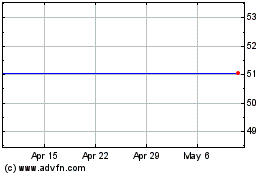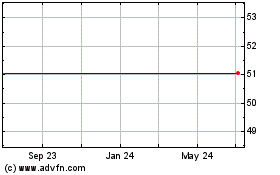By Sarah Kent
Major oil companies are doubling down on gas stations,
refineries and processing plants, betting on a once-unloved part of
the energy business to shore up profits and expand their customer
bases.
BP PLC plans to open thousands of gas stations in new markets
such as Mexico and India over the next three years. Exxon Mobil
Corp. is investing heavily to expand its petrochemical operations,
which make products like plastics and the basic ingredients for all
sorts of household goods. In November, Royal Dutch Shell PLC
started work on a massive petrochemical complex in Pennsylvania --
its first big new plant in the U.S. since the 1960s.
Companies are expected to add 7.7 million barrels a day of new
refining capacity by 2023, according to the International Energy
Agency. In petrochemicals, it estimates investment in the U.S.
alone over the next five years will add 13 million tons a year of
new capacity to produce ethylene, the main component of
plastic.
American refining, in particular, is booming. Surging shale
production has provided plentiful, cheap oil close to the country's
petrochemical heartland around the Gulf Coast. Fuel demand is
expected to rise. All those dynamics helped drive Marathon
Petroleum Corp.'s agreement to buy rival Andeavor last month for
$23 billion, a deal that would create the country's largest
refiner.
As smaller refiners consolidate, the world's major oil companies
are promising that investment in their so-called downstream
businesses -- and restructuring efforts they are simultaneously
pursuing to improve efficiency -- will add billions of dollars to
earnings. The focus on downstream grew amid a period of lower oil
prices and concerns over long-term oil demand. Cheaper crude -- the
primary feedstock for refining -- boosted margins and profits. Oil
companies' "upstream," or oil exploration and development,
meanwhile, was suffering from lower prices.
"Upstream at some point was not making money," said Tufan
Erginbilgic, head of BP's refining and retail arm. That gave his
unit a fresh imperative to "really significantly contribute to
group performance, because we have to."
Today, higher crude prices pose a risk that margins from
refining won't be as strong as they have in recent years. And all
the new investment in capacity could end up swamping the market,
analysts warned.
"It remains to be seen the way demand is going to shape up,"
said Jonathan Leitch, research director at Edinburgh-based
consultancy Wood Mackenzie.
Big companies say the downstream investment is worth it -- no
matter where crude prices head. Executives say that integrating the
oil they produce with refining and retail businesses can maximize
profits, and help steady finances amid the sometimes-wild swings in
crude.
Investor pressure also has mounted on the major oil companies to
start positioning for an age when fossil fuels may no longer power
the world's fleet of passenger cars. Executives are betting their
big petrochemical plants can offer diversification. According to
the IEA, petrochemical production is expected to be the biggest
driver of oil demand growth in the coming decades.
Gas stations, too, are promising new growth. They offer access
to emerging markets, where demand for fuel is expected to be
especially robust. A geographically wide network of branded, retail
outlets also could create new opportunities where the industry now
sees threats -- such as electric charging stations.
Last year, Shell bought one of Europe's biggest electric-vehicle
charging companies, New Motion. It has teamed up with a group of
car manufacturers to install more than 500 fast-charging points at
existing Shell stations, across 10 countries in Europe over the
next two years.
The rise of electric vehicles is "a reality, and an
opportunity," Shell's downstream director, John Abbott, told
analysts in March. "We are adjusting our offer to meet this new
demand."
BP started its push before oil prices collapsed in 2014. The
company was seeking stability after selling off billions of dollars
in assets to pay for cleanup fees and legal costs associated with
its catastrophic blowout in the Gulf of Mexico in 2010.
It sold off some of its refining businesses but resisted
investor pressure to get rid of its downstream unit altogether.
That was despite it being an industry laggard. Mr. Erginbilgic, the
downstream boss, eliminated a layer of management and ordered up
targeted improvement plans at each plant.
"At that time, we were the worst in the industry. Literally the
worst," he said. BP says now it is on track to increase earnings
from Mr. Erginbilgic's division by $3 billion between 2017 and
2021, doubling the improvement made in the two years from 2014.
Over the next three years, BP sees the biggest opportunity to
boost earnings in gas stations. It is doubling down on partnerships
with convenience stores, which has boosted profitability at gas
stations in mature markets, and is pushing hard into new countries
where demand is expected to grow.
BP says it is on track to open 500 retail sites in Mexico by the
end of the year, up from zero at the start of 2017. Elsewhere, it
is looking to build gas stations in India, China and Indonesia.
Write to Sarah Kent at sarah.kent@wsj.com
(END) Dow Jones Newswires
May 16, 2018 08:14 ET (12:14 GMT)
Copyright (c) 2018 Dow Jones & Company, Inc.
Royal Dutch Shell (NYSE:RDS.A)
Historical Stock Chart
From Mar 2024 to Apr 2024

Royal Dutch Shell (NYSE:RDS.A)
Historical Stock Chart
From Apr 2023 to Apr 2024
